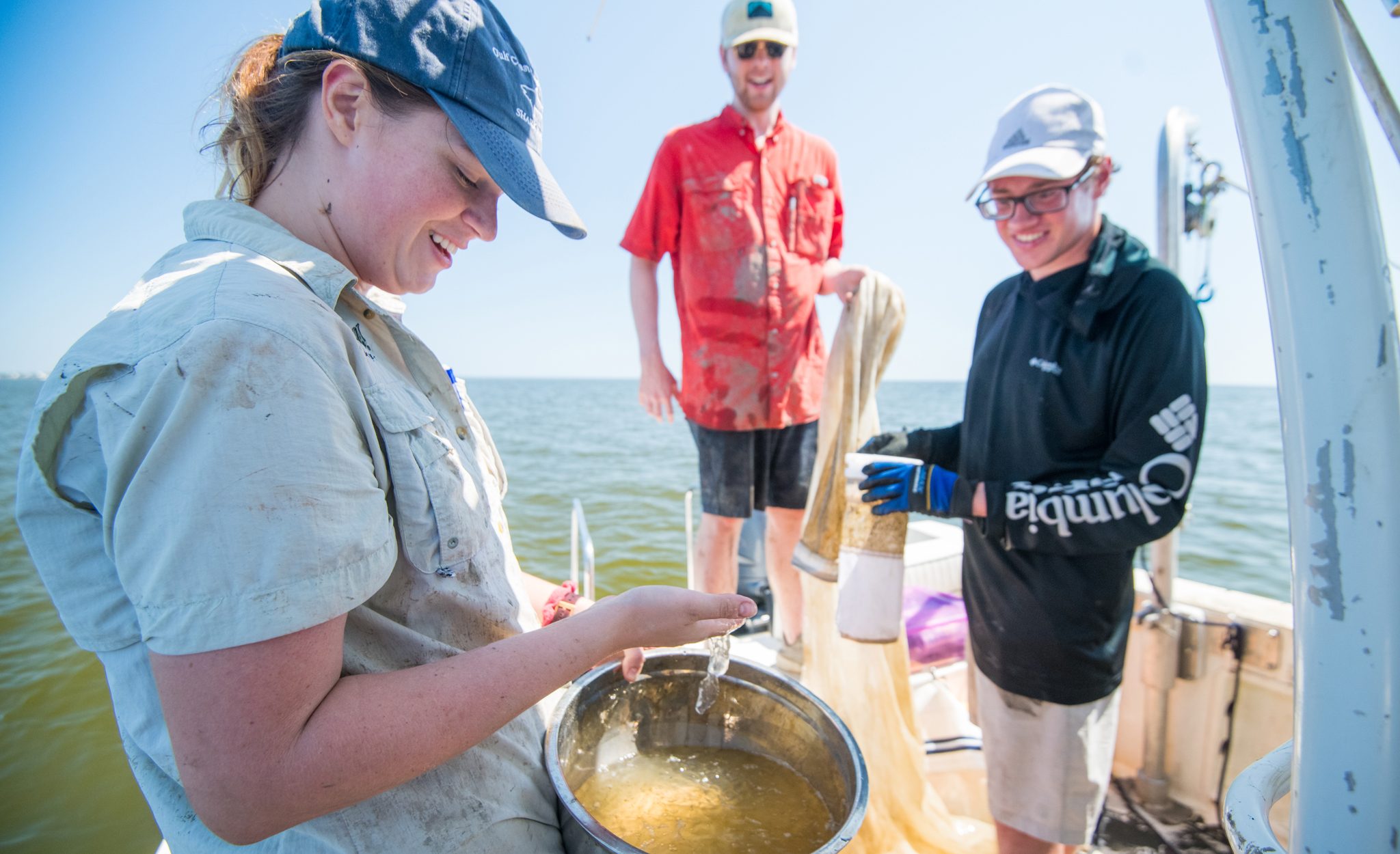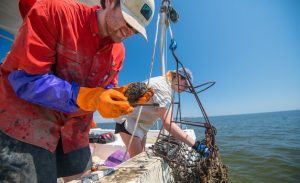
UM environmental toxicology master’s program graduates (from left) Ann Fairly Barnett and James Gledhill and chemistry graduate student Austin Scircle measure water quality and pH levels in the Mississippi Sound as part of a project in conjunction with the Mississippi-Based RESTORE Act Center of Excellence. Photo by Kevin Bain/Ole Miss Digital Imaging Services
OXFORD, Miss. – As Ann Fairly Barnett pulled an oyster dredge up through the shoreline waters of the Mississippi Sound, she was dreading what she was about to find.
“Not a single living oyster,” said the University of Mississippi master’s student in environmental toxicology.
The Jackson native, along with UM environmental toxicology graduate student James Gledhill and chemistry graduate student Austin Scircle, had chartered a small fishing boat to visit several native oyster reefs in the sound to check the water quality and the health of the reefs.
Two months before, the Bonnet Carre Spillway had closed after having been open for a record 121 days in 2019. Unusually high rainfall in the Midwest in early 2019 had dumped excess freshwater into feeder streams to the Mississippi River, eventually prompting the Army Corps of Engineers to open the spillway to prevent flooding, sending the excess freshwater into the Mississippi Sound.
This marked the first time the spillways had been opened twice in one year and in consecutive years, and the excess freshwater had diluted the salinity of the water in the sound.
“The salinity dropped in some places to fresher than tap water,” Barnett said. “This is really detrimental to marine life. Oysters are bivalves that can close during stress, but when it lasts that long, they have to open up.”
Along with examining the oysters, Barnett and her fellow graduate students also placed six sensor platforms around Bay St. Louis to measure water quality conditions, such as salinity and dissolved oxygen. Although they were expecting to find dead oysters as a result of the spillway opening, they were surprised to find no living oysters.
“It’s either flood these major areas or release the water into the sound,” Barnett said. “So for Mississippi’s oyster reef restoration, we need to consider that these (rainfall) events are going to keep happening, especially with projections of climate change.”
Barnett and Gledhill, who recently defended their master’s theses in the UM School of Pharmacy‘s Department of BioMolecular Sciences, are drafting a manuscript that they hope will show the impact of opening the spillway.
Marc Slattery, an Ole Miss pharmacognosy and environmental toxicology professor who is familiar with Barnett’s and Gledhill’s research, is part of the executive steering committee of MBRACE, which studies environmental stressors in the Gulf of Mexico.

UM environmental toxicology master’s program graduates James Gledhill (left) and Ann Fairly Barnett examine dead oysters they pulled from the Mississippi Sound with an oyster dredge. Oyster mortality in the sound has increased due to heavy rainfall dumping excess freshwater into it. Photo by Kevin Bain/Ole Miss Digital Imaging Services
“Both Ann Fairly and James got in on some specific questions early on about whether there were any specific toxins or pollutants at those sites that might be problematic,” Slattery said.
“But they sort of shifted gears when we saw the very heavy rainfall over the past couple years due to climate change.”
To plan a data-gathering trip to the Mississippi Sound, the students coordinate schedules with the boat’s captain, gather supplies they’ll need for water testing and oyster dissection and then watch the weather. After all their preparation, too much wind could cancel the trip. Time on the boat is spent visiting each oyster reef site, collecting samples and recording water quality parameters with a handheld meter.
Scircle studies the prevalence and the impact of microplastics in the Mississippi River and in the Gulf. He is developing a technique for using fluorescence to measure the amount of microplastics in a way that is uniquely suited to the silty, sediment-rich waters of the Mississippi River and the Gulf.
His research takes him to many of the same spots where Barnett and Gledhill collect oysters, and the three students’ research has become interconnected.
“The Gulf Coast serves as habitat for a lot of sensitive organisms,” Scircle said. “These microplastics are pretty abundant, and you don’t like to find them in these nurseries and in oysters that people might eat.”
On their trip out into the sound, the students found low oxygen conditions, areas of extremely low salinity and low pH, and damage from pollution, dredging and boat wakes that contributed to incredibly high stress within oyster estuaries.
“Oysters offer a lot of different ecosystem services,” Gledhill said. “They are constantly filtering water; they provide a buffer against shoreline erosion; they provide habitat for fish species and other animals that live in estuaries.
“Since this freshwater has come in, at our sites, we’ve lost those ecosystem services. I think that’s why restoration efforts are so important.”
This project was paid for in part with Federal funding through the U.S. Department of the Treasury and the Mississippi Department of Environmental Quality under the Resources and Ecosystems Sustainability, Tourist Opportunities and Revived Economies of the Gulf Coast States Act of 2012, known as the RESTORE Act.
The statements, findings, conclusions and recommendations are those of the author(s) and do not necessarily reflect the view of the Department of the Treasury or the Mississippi Department of Environmental Quality.